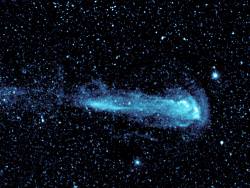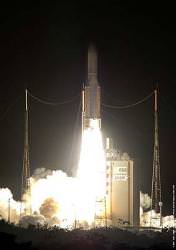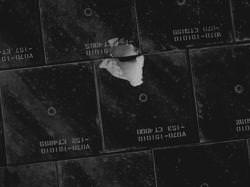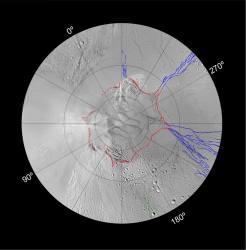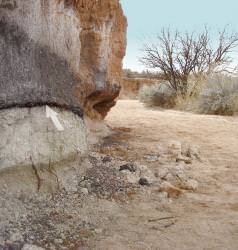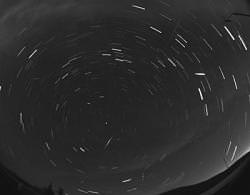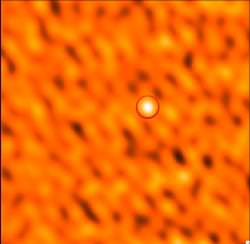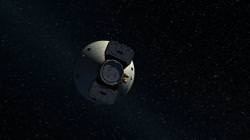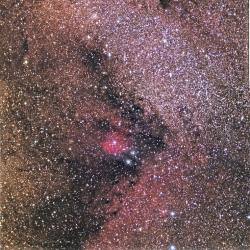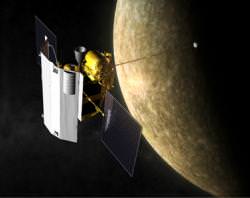Monday, August 13 – Tonight, begin with just your eyes as you gaze about four fingerwidths above the top of the Sagittarius “teapot dome” for an open window on the stars and the magnificent M24…
This huge, hazy patch of stars is in reality an area of space known as “Baade’s Window” – an area free of obscuring gas and dust. Cataloged by Messier in 1764 as object 24, even small binoculars will reveal the incredible vista of the “Sagittarius Star Cloud.” Although it’s actually not a cluster, but rather a clean view of an area of our own galaxy’s spiral arm, that will not lessen the impact when viewed through a telescope. Spanning a degree and a half of sky, it is one of the few areas in which even a novice can easily perceive areas of dark dust.
For larger telescopes, look for the dim, open cluster NGC 6603 in the northeastern position of the Window. There are two very notable dark nebulae, B92 and B93, located in the northern segment as well. Near teardrop shaped B92 and its single central star, you should spot open cluster Collinder 469 and also Markarian 38 south of B93. You’ll find B86 near Gamma Sagittarii . At the southern edge of the star cloud, look for emission nebula IC 1283-1284, along with the reflection nebulae NGC 6589 and NGC 6590 and open cluster NGC 6595. Still up for more? Then head west to see if you can find 12th-magnitude planetary nebula NGC 6567.
Even if you don’t accept these challenges, you can still enjoy looking at a 560 light-year swatch of stars from one of the Milky Way’s loving arms! (If you’re out late, look for Mira… It was discovered by Fabricius on this date in 1596.)
Tuesday, August 14 – Your first challenge for tonight will be to see if you can spot the tender, slender, beginnings of the Moon as it graces the sky just as the Sun sets. It isn’t easy, but it doesn’t take any special equipment – just clear skies and a good view of the western horizon!
Tonight let’s venture about three fingerwidths northeast of Lambda Sagittarii to visit a well-known but little visited galactic cluster – M25.
First discovered by Chéseaux and then cataloged by Messier, it was observed and recorded by William Herschel, Johann Elert Bode, Admiral Smythe and T. W. Webb…but never added to the NGC catalog of John Herschel! Thanks to J.L.E. Dreyer, it did make the second Index Catalog as IC 4725.
Seen with even the slightest optical aid, this 5th magnitude cluster contains two G-type giants as well as a Delta Cephei-type variable with the designation of U, which changes about one magnitude in a period of less than a week. It’s very old for an open cluster, perhaps near 90 million years, and the light you see tonight left the cluster over 2000 years ago. While binoculars will see around a double handful of bright stars overlaying fainter members, telescopes will reveal more and more as aperture increases. At one time it was believed to have only about 30 members, but this was later revised to 86. But recent studies by Archinal and Hynes indicate it may have as many as 601 member stars!
Wednesday, August 15 – Tonight the Moon just after sunset will become a little more obvious, but it soon will be gone – leaving us to head back to Scorpius to have a look at three pristine open clusters. Begin your starhop at the colorful southern Zeta pair and head north less than one degree for NGC 6231.
Wonderfully bright in binoculars and well resolved to the telescope, this tight open cluster was first discovered by Hodierna before 1654. De Chéseaux cataloged it as object 9, Lacaille as II.13, Dunlop as 499, Melotte as 153, and Collinder as 315. No matter what catalog number you chose to put in your notes, you’ll find the 3.2 million year young cluster shining as the “Northern Jewelbox!” For high power fans, look for the brightest star in this group – it’s van den Bos 1833, a splendid binary.
About another degree north is loose open cluster Collinder 316, with its stars scattered widely across the sky. Caught on its eastern edge is another cluster known as Trumpler 24, a site where new variables might be found. This entire region is encased in a faint emission nebula called IC 4628 – making this low power journey through southern Scorpius a red hot summer treat!
Thursday, August 16 – If you did not get a chance to look at the Northern Jewelbox region in Scorpius, return again and sweep the area tonight. For those with larger telescopes, we’re going to hop about a degree and a half south of twin Nu for NGC 6242.
Discovered by Lacaille and cataloged as I.4, it is also known as Dunlop 520, Melotte 155 and Collinder 317. At roughly magnitude 6, this open cluster is within binocular range, but truly needs a telescope to appreciate its fainter stars. While NGC 6242 might seem like nothing more than a pretty little cluster with a bright double star, it contains an x-ray binary which is a “runaway” black hole. It is surmised that it formed near the galactic center and was vaulted into an eccentric orbit when the progenitor star exploded. Its kinetic energy is much like a neutron star or a millisecond pulsar, and it was the first black hole confirmed to be in motion.
Now head a little more than a degree east-southeast for NGC 6268. At a rough magnitude of 9, this small open cluster can be easily observed in smaller scopes and resolved in larger ones. The cluster itself is somewhat lopsided, with more of its members concentrated on the western half of its borders. While it, too, might not seem particularly interesting, this young cluster is highly evolved and contains some magnetic, chemically peculiar stars and Be class, or metal-weak, members.
Friday, August 17 – Today in 1966 Pioneer 7 was launched. It was the second in a series of satellites sent to monitor the solar wind, and study cosmic rays, interplanetary space, and magnetic fields.
Tonight it’s going to be very hard to ignore the Moon, so why don’t we start by studying it and picking up another lunar club challenge? Your mission is to locate crater Petavius along the southeast shore of Mare Fecunditatis and have a look at the Petavius Wall…
While you’re admiring Petavius and its branching rima, keep in mind this 80 kilometer long crack is a buckle in the lava flow across the crater floor. Now look along the terminator for the long, dark runnel which is often considered to be the Petavius Wall but is actually the fascinating crater Palitzsch. This 41 kilometer wide crater is confluent with a 110 kilometer long valley that is outstanding at this phase!
Although skies are bright, return to previous study star Lambda Scorpii and hop three fingerwidths northeast… We’re hunting the “Butterfly!”
Easily seen in binoculars and tremendous in the telescope, this brilliant magnitude 4 open cluster was first discovered by Hodierna before 1654 and independently discovered by de Chéseaux as his object 1, before being cataloged by Messier as M6. Containing around 80 stars, the light you see tonight left its home in space around the year 473 A.D. It is believed to be around 95 million years old and contains a single yellow supergiant – the variable BM Scorpii. While most of M6’s stars are hot, blue main sequence, the unique shape of this cluster gives it not only visual appeal, but wonderful color contrast as well!
Saturday, August 18 – Tonight as the Sun sets and the stars begin to appear, look for Spica no more than a fingerwidth north of the Moon. As the skies darken, we’ll venture to the surface near previous study Posidonius to have a look at the incredible Serpentine Ridge. Known more properly as Dorsa Smirnov, it meanders for 130 kilometers north to south across Mare Serenitatis. Can you spot tiny the crater Very in its center?
On this day in 1868, Norman Lockyer was very busy as he was the first to see helium absorption lines in the Sun’s spectrum. Tonight we’ll take a walk from helium rich Lambda Scorpii about three fingerwidths east-northeast to an even more prominent area of stars that was known to Ptolemy as far back as 130 AD.
Astronomers throughout the ages have spent time with this cluster: Hodierna as Ha II.2; Halley in 1678 as number 29, Derham in 1733 as number 16, De Chéseaux as number 10, Lacaille as II.14; Bode as 41; once for William Herschel and again for John as h 3710; Dreyer as NGC 6475… But we know it best as Messier Object 7.
Set against the backdrop of the Milky Way, even the smallest of binoculars will enjoy this bright open cluster while telescopes can resolve its 80 members. Roughly 800 light-years away, it contains many different spectral types in various stages of evolution, giving the cluster an apparent age of about 260 million years. Full of binaries and close doubles, an extreme test of tonight’s lighting conditions would be to see if you can spot the 11th magnitude globular cluster NGC 6543 to the northwest!
Sunday, August 19 – Born today in 1646, let’s have a look at John Flamsteed. He was an English astronomer with a passion for what he did. Despite a rather difficult childhood and no formal education, he went on to become the First Observer at the Royal Observatory and his catalog of 3000 stars was perhaps the most accurate yet published. Flamsteed star numbers are still in use. Also born on this day was Orville Wright, in 1871, and in 1891, Milton Humason, a colleague of Edwin Hubble at Mts. Wilson and Palomar. The latter was instrumental in measuring the faint spectra of galaxies, which in turn provided evidence for the expansion of the universe.
So… Are you ready to do a lunar walk for a challenge crater we haven’t listed yet? Then look to the northwest shore of Mare Serenitatis for the pair of Aristoteles and Eudoxus. What’s that? You see more? Then mark your notes for Eudoxus and let’s have a look at many other studies you may not have noted yet!
1) Burg, 2) Barrow, 3) Grove, 4) Daniel, 5) Posidonius, 6) Apollo 17 Landing Area, 7) Plinius, 8) Bessel, 9) Menelaus, 10) Manilius, 11) Apennine Mountains, 12) Conon, 13) Palus Putredinus, 14) Mons Hadley, 15) Archimedes, 16) Autolycus, 17) Aristillus, 18) Mons Piton, 19) Cassini, 20) Caucasus Mountains, 21) Calippus, 22) Alexander, 23) Eudoxus, 24) Mare Serenitatis, 25) Linné, 26) Haemus Mountains.

